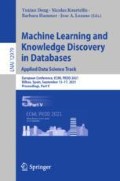Abstract
Neural networks are a popular tool in e-commerce, in particular for product recommendations. To build reliable recommender systems, it is crucial to understand how exactly recommendations come about. Unfortunately, neural networks work as black boxes that do not provide explanations of how the recommendations are made.
In this paper, we present TransPer, an explanation framework for neural networks. It uses novel, explanation measures based on Layer-Wise Relevance Propagation and can handle heterogeneous data and complex neural network architectures, such as combinations of multiple neural networks into one larger architecture. We apply and evaluate our framework on two real-world online shops. We show that the explanations provided by TransPer help (i) understand prediction quality, (ii) find new ideas on how to improve the neural network, (iii) help the online shops understand their customers, and (iv) meet legal requirements such as the ones mandated by GDPR.
Supported by the German Research Ministry (BMBF), the Smart Data Innovation Lab (01IS19030A), and the company econda GmbH.
Access this chapter
Tax calculation will be finalised at checkout
Purchases are for personal use only
Notes
- 1.
We provide the source code online at https://github.com/Krusinaldo9/TransPer.
References
Ancona, M., Ceolini, E., et al.: Towards better understanding of gradient-based attribution methods for Deep Neural Networks. In: ICLR (2018)
Bach, S., Binder, A., et al.: On pixel-wise explanations for non-linear classifier decisions by layer-wise relevance propagation. PLoS ONE 10(7) (2015)
Bettaney, E.M., Hardwick, S.R., et al.: Fashion outfit generation for e-commerce. In: eCom@SIGIR. CEUR, vol. 2410 (2019)
Bharadhwaj, H.: Layer-wise relevance propagation for explainable deep learning based speech recognition. In: IEEE ISSPIT, pp. 168–174 (2018)
Borisov, A., Markov, I., et al.: A neural click model for web search. In: WWW Conference, pp. 531–541 (2016)
Chen, M., Liu, P.: Performance evaluation of recommender systems. Int. J. Performability Eng. 13, 1246 (2017)
Chen, W., Huang, P., et al.: POG: personalized outfit generation for fashion recommendation at Alibaba iFashion. In: ACM SIGKDD, pp. 2662–2670 (2019)
econda: Personalization & Analytics. https://www.econda.de. Accessed 29 Mar 2021
Gebremeskel, G.G., de Vries, A.P.: Recommender systems evaluations: offline, online, time and A/A test. In: CLEF. CEUR, vol. 1609, pp. 642–656 (2016)
General Data Protection Regulation: Art. 12 GDPR. https://gdpr-info.eu/art-12-gdpr/. Accessed 29 Mar 2021
Khoali, M., Tali, A., et al.: Advanced recommendation systems through deep learning. In: NISS, pp. 51:1–51:8 (2020)
Laenen, K., Moens, M.: A comparative study of outfit recommendation methods with a focus on attention-based fusion. Inf. Process. Manag. 57(6), 102316 (2020)
Li, Y., Cao, L., et al.: Mining fashion outfit composition using an end-to-end deep learning approach on set data. IEEE Trans. Multim. 19(8), 1946–1955 (2017)
Loureiro, A.L.D., Miguéis, V.L., et al.: Exploring the use of deep neural networks for sales forecasting in fashion retail. Decis. Support Syst. 114, 81–93 (2018)
Montavon, G., Binder, A., Lapuschkin, S., Samek, W., Müller, K.-R.: Layer-wise relevance propagation: an overview. In: Samek, W., Montavon, G., Vedaldi, A., Hansen, L.K., Müller, K.-R. (eds.) Explainable AI: Interpreting, Explaining and Visualizing Deep Learning. LNCS (LNAI), vol. 11700, pp. 193–209. Springer, Cham (2019). https://doi.org/10.1007/978-3-030-28954-6_10
Montavon, G., Samek, W., et al.: Methods for interpreting and understanding deep neural networks. Digital Signal Process. 73, 1–15 (2018)
Nelaturi, N., Devi, G.: A product recommendation model based on recurrent neural network. Journal Européen des Systèmes Automatisés 52, 501–507 (2019)
Nguyen, A., Oberföll, A., Färber, M.: Right for the right reasons: making image classification intuitively explainable. In: Hiemstra, D., Moens, M.-F., Mothe, J., Perego, R., Potthast, M., Sebastiani, F. (eds.) ECIR 2021. LNCS, vol. 12657, pp. 327–333. Springer, Cham (2021). https://doi.org/10.1007/978-3-030-72240-1_32
Noh, H., Hong, S., et al.: Learning deconvolution network for semantic segmentation. In: IEEE ICCV, pp. 1520–1528 (2015)
Park, S.: Neural networks and customer grouping in e-commerce: a framework using fuzzy ART. In: AIWoRC, pp. 331–336 (2000)
Rumelhart, D.E., Hinton, G.E., et al.: Learning representations by back-propagating errors. Nature 323(6088), 533–536 (1986)
Shrikumar, A., Greenside, P., et al.: Learning important features through propagating activation differences. In: ICML, vol. 70, pp. 3145–3153 (2017)
Simonyan, K., Vedaldi, A., et al.: Deep inside convolutional networks: visualising image classification models and saliency maps. In: ICLR (2014)
Springenberg, J.T., Dosovitskiy, A., et al.: Striving for simplicity: the all convolutional net. In: ICLR (2015)
Sundararajan, M., Taly, A., et al.: Axiomatic attribution for deep networks. In: ICML, vol. 70, pp. 3319–3328 (2017)
Yuan, J., Li, Y.-M., Liu, C.-L., Zha, X.F.: Leave-one-out cross-validation based model selection for manifold regularization. In: Zhang, L., Lu, B.-L., Kwok, J. (eds.) ISNN 2010. LNCS, vol. 6063, pp. 457–464. Springer, Heidelberg (2010). https://doi.org/10.1007/978-3-642-13278-0_59
Author information
Authors and Affiliations
Corresponding author
Editor information
Editors and Affiliations
Rights and permissions
Copyright information
© 2021 Springer Nature Switzerland AG
About this paper
Cite this paper
Nguyen, A., Krause, F., Hagenmayer, D., Färber, M. (2021). Quantifying Explanations of Neural Networks in E-Commerce Based on LRP. In: Dong, Y., Kourtellis, N., Hammer, B., Lozano, J.A. (eds) Machine Learning and Knowledge Discovery in Databases. Applied Data Science Track. ECML PKDD 2021. Lecture Notes in Computer Science(), vol 12979. Springer, Cham. https://doi.org/10.1007/978-3-030-86517-7_16
Download citation
DOI: https://doi.org/10.1007/978-3-030-86517-7_16
Published:
Publisher Name: Springer, Cham
Print ISBN: 978-3-030-86516-0
Online ISBN: 978-3-030-86517-7
eBook Packages: Computer ScienceComputer Science (R0)


